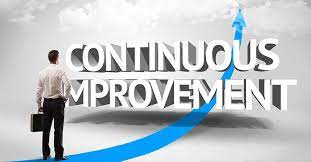Continuous improvement is a way of systematically improving business processes to increase productivity and efficiency. It can have a big impact on employee engagement, customer satisfaction and overall company profitability.
A key to a successful CI program is involving employees in the process. When you engage them, they become more invested in their work and more willing to contribute suggestions for improvement.
Employee Engagement
Creating a culture of continuous improvement is one of the cornerstones for effective employee engagement. It is a process that is self-perpetuating, and it’s important to keep an eye out for slight improvements over time to keep the cycle going.
To start, consider conducting a company-wide employee engagement survey to establish a baseline and measure across groups and teams. This will give you a 30,000-foot view of your strengths and opportunities.
Then, use the feedback gathered to inform your engagement strategies and improve your outcomes. Ultimately, this is a process of continuous improvement that will yield significant business results.
When employees feel a strong connection to their organization, they are more likely to perform at a high level and remain loyal to their company over the long haul. Moreover, a workplace with a strong sense of belonging also leads to higher levels of employer net promoter scores (eNPS)—an important metric used by many businesses as a benchmark for customer satisfaction.
Collaborative Goal Planning
Collaborative goal planning is a Continuous improvement strategy that combines the benefits of teamwork and open communication. The process allows managers to share ideas with their employees and establish goals that align with company objectives.
Having clear, meaningful goals that are linked to broader corporate goals builds employee engagement and promotes accountability for results. This increases staff retention by 2.5 times and improves corporate culture.
It also creates a culture of trust that encourages innovation and growth. Unlike traditional goal-setting processes, collaborative goals prioritize transparency and teamwork. They can be adjusted quickly to accommodate changes in business strategy or objectives, keeping employees aligned and motivated.
Individualized Coaching & Feedback
If used thoughtfully and with intent, feedback, and coaching support learning, performance improvement, and personal or professional development. They also foster a positive workplace environment and employee morale.
The most effective forms of feedback are information and advice, not evaluation or analysis. They focus on the goals that the person has set and offer details about their actions to help them achieve those goals.
Providing goal-related feedback builds trust and respect in the relationship between supervisor and trainee, and it is a social interaction based on mutual commitment. Moreover, providing feedback in a two-way conversation between supervisor and learner supports learners’ acceptance of and acting upon it.
Feedback and coaching are key to advancing the developmental progression of medical students and residents as they work towards achieving competence throughout their training. They also promote positive working relationships between supervisors and learners and create an institutional culture that embraces feedback and coaching as core practices.
Pilot Programs
Pilot programs are short-term experiments designed to help organizations learn how a larger-scale project might work in practice. Also known as feasibility studies or experimental trials, they provide a platform to test logistics, prove value and uncover deficiencies before spending time, energy and money on the project.
Many organizations rely on pilot programs to manage risk, save time and money, and define the path forward for new technologies or solutions. But pilots can fail if they’re not conducted correctly.
Leaders must ensure that pilot teams are organized, have clear roles and responsibilities, and know how to monitor their results. They should also solicit feedback and record changes and improvements made in order to achieve desired outcomes.
While it may seem like a short-term commitment, embracing the pilot approach will ultimately make your organization faster and more efficient in the long run. Taking this iterative, incremental approach to implementing changes will allow your team leaders to course-correct easier and achieve results more quickly.







